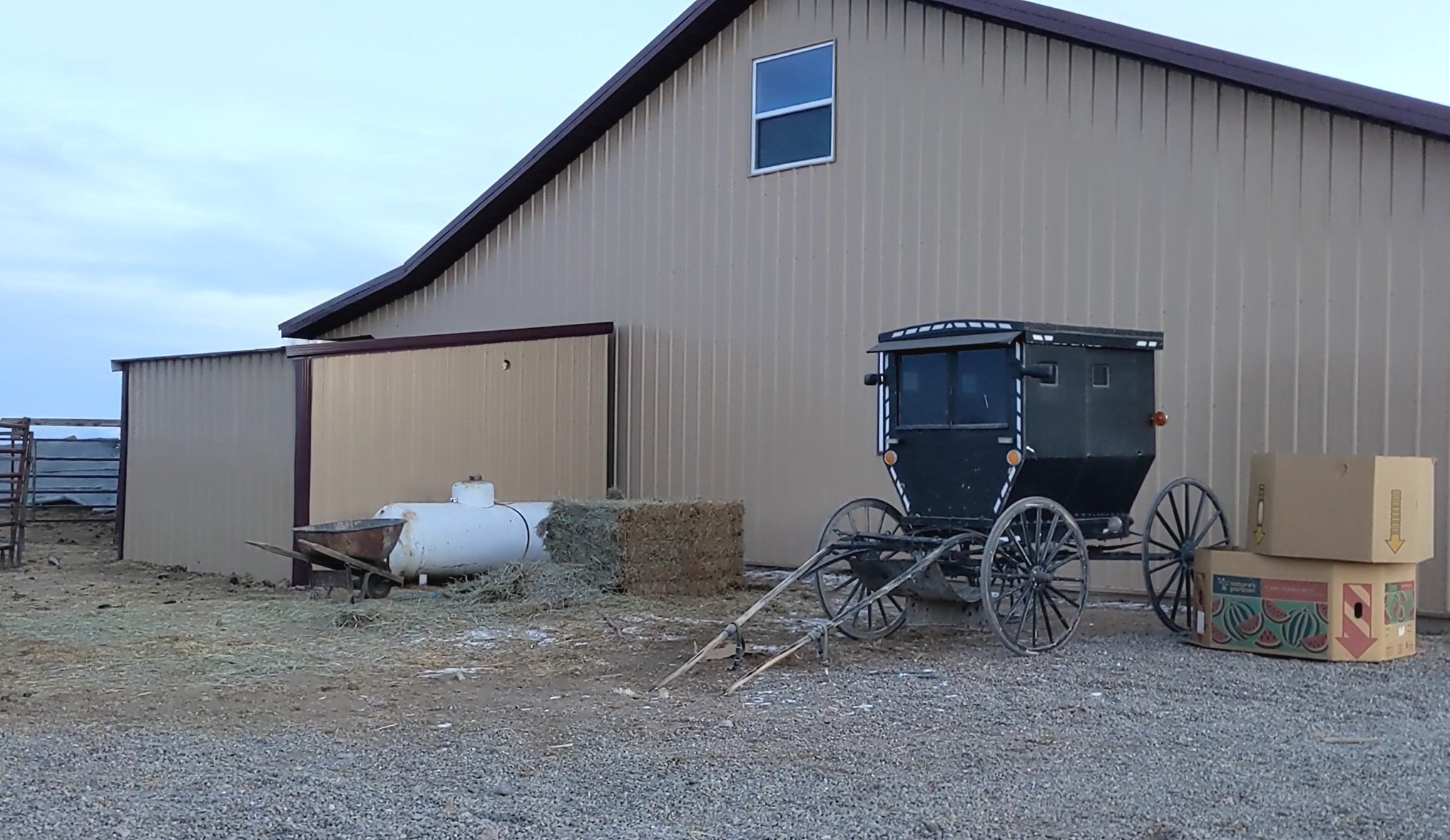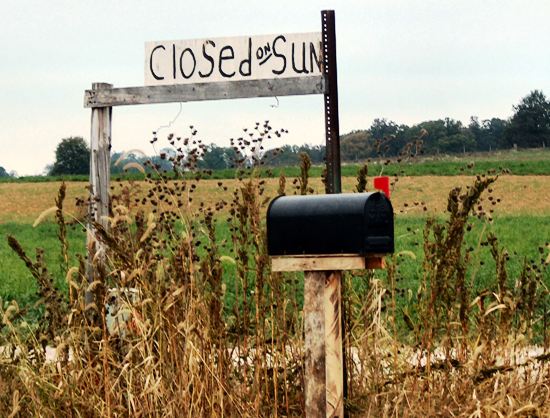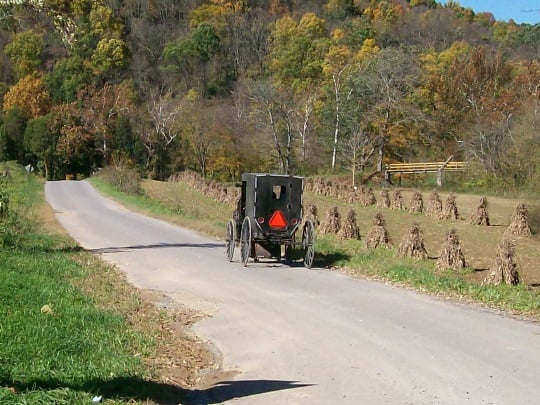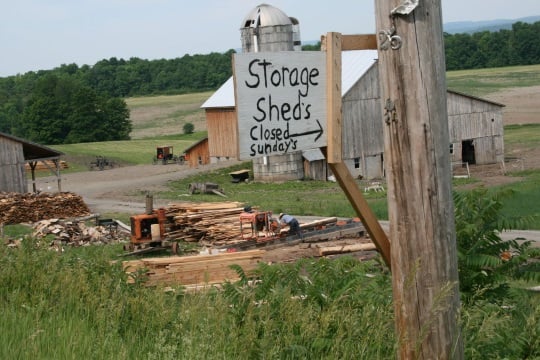Amish Population 2022: Amish Call New Mexico Home
The latest Amish population statistics have been released by the Young Center for Anabaptist & Pietist Studies at Elizabethtown College. After looking over the numbers I can share that – no surprise here – the Amish population is larger this year than the last. The new estimated tally is 373,620, an increase of a bit over 12,000 over the past year.

This rate of growth suggests that by 2024 (or 2025 at the latest), the Amish population will surpass 400,000 souls. In addition to the population tables linked above, you can access the 2022 Population Profile as well as the 2013-2022 growth chart.
New Mexico joins the club
The most interesting piece from the new figures is the addition of New Mexico to the list, becoming the 32nd state with a current Amish population. I caught word of this at the Amish conference at Elizabethtown last month, and have since been looking forward to sharing more about it.
But, there are a couple of curious details worth addressing here. First, the 2022 Amish County and State list dates the founding of this community to 2020.
But, why is it appearing just now on the 2022 list?
What likely happened is that the initial family or families settled the area in 2020. But at that time, they hadn’t reached “settlement size”, which based on a generally-accepted definition proposed by Amish historian David Luthy years ago, is three families, or two (if one is a minister).

So even though the first family or families came in 2020, it took until the next year, or this year, for a substantial number of families to join them.
Looking at notes from the Central Plains Amish Directory 2021 shared by Edsel Burdge of the Young Center (one of a handful of diligent souls responsible for compiling these figures), it seems that only one family settled here in 2020. Several more arrived in 2021 and two more in 2022.

I can also add based on info from the Young Center that until last year they weren’t sure if this was an independent settlement, or simply an extension of a Colorado settlement, going by Amish scribe (correspondence-letter writer) reports. But after a phone call from Edsel, it was learned that this is a distinct community.
Ortiz…NM?
The second curious detail is the precise location of this community. The notes from Central Plains Amish Directory 2021 show multiple references to the settlement’s location as Ortiz, NM.
But…there is no Ortiz, NM. There is an Ortiz, CO, however, an unincorporated community lying just over the state border in Conejos County. The Amish publication The Diary also refers to an Ortiz, CO.
Edsel writes that likely this “settlement is right on the NM/CO border.” It seems to be that this community consists of Amish households mainly or totally on the New Mexico side of the border – but who are using the Ortiz, CO community as the nearest place name to refer to their own settlement. And since they are physically living in New Mexico, the reference becomes Ortiz, NM.

This makes sense, because if you look at the map of that area of New Mexico, there are no towns anywhere near the area (the nearest marked place name is the “San Antonio Wilderness Area”). This place is pretty remote.

That’s what I would surmise based on the info available here.
As far as the community’s origins, Edsel adds that “there does seem to be a close working relationship with Westcliffe, CO”. This makes me wish I had known of this settlement when I visited Westcliffe in December. Would have made a nice stop (especially as we drove a few miles past Ortiz into New Mexico, just to add New Mexico to the “states-visited” list 🙂 ).

I remember thinking that the nearest Colorado community, La Jara, was not so far away from New Mexico and it would seem feasible for a community to appear at some point over the border.

Families have moved to this settlement from Westcliffe as well as communities in Michigan, Indiana, and it appears Kansas. They have a school there, and an estimated 30 people in the settlement (around a half-dozen households). So, hopefully this community will do well and last longer than a prior attempt to settle in the state…
Not New Mexico’s first Amish
A final note: this is not the first time Amish have settled in the Land of Enchantment. They lived there at least one other time – from 1921 to 1929, in Colfax County, near the settlement of Chico. You can read a brief history of the Chico, NM settlement via GAMEO, or a more in-depth one in David Luthy’s The Amish in America: Settlements that Failed, 1840-1960.
Eleven Amish families moved there from Kansas. After an initial good start, an extended period of drought caused most to move back to Kansas after a few years. However one family, D.Y. and Susan Bontrager remained in the area until 1929. Interestingly, they made a living by growing “diversified crops”, among them pinto beans and onions. Additionally, they produced adobe building blocks for sale.
I doubt New Mexico’s current Amish residents are earning their dinner from adobe block production, but you never know.







Fly!
Get on an airplane and take a flight. Are there any lines on the ground? No? Now do you see? These Folk are still with their brothers and sisters; only a split out populace, necessary because there were then more than 200 people in the old community.
Pretty sure this was by plan. The Amish folk are excellent planners, and they will be the survivors.
Stay separate
I know this area well as I grew up in Alamosa. I will say that in this case I’m glad the Amish stay separate. There are a lot of drugs there and not the safest place to be.
Population growth…or lack there of.
Always find these population numbers interesting but it always makes me wonder why some places grow and some do not. For example the Hutchinson and Haven/Yoder, Kansas settlements were both founded in 1883 and are only 2 and 3 church districts respectively. These settlements are also really close geographically. Meanwhile the Geauga, Ohio settlement was founded three years later in 1886 and has grown to be the 4th largest Amish settlement with 154 church districts. Why did Geauga grow so large while the Kansas settlements remained small and separate, instead of themselves growing into one large settlement? I’m sure there are a multitude of reasons. I still find it interesting.
Very old Amish communities that remain small
That’s one thing that fascinates me as well. Those 3 Kansas communities are great examples. Another is the settlement in Somerset County, PA, one of only 3 founded in the 1700s. Only about a half-dozen churches in size. They are a bit different however with the use of meetinghouses which might be a part of it. I think there is some history on that one explaining it but I’d have to look it up again.
As you say I think it’s probably more complex than just one factor. Enon Valley, PA is another like that – just 1 church and around 100 years old. One Amish person I know gave at least a partial explanation for that one though:
” An Amish person quite familiar with the community shared with me a few other things, some of which shed light on the above. He said it was something like a fusion of the Nebraska Amish and the New Wilmington Amish (I am assuming he meant Ordnung).
He also described it as a “stepping-stone” settlement to higher churches, noting that if that were not the case, it would be very large, while currently he guessed it has only about 15 households.”
https://amishamerica.com/amish-enon-valley-pennsylvania/
Very old Amish communities that remain small
Those are great examples Erik. The other ones that stick out in my mind are Kokomo, Indiana (1848 and 2 churches), Garnett, Kansas (1903 and 2 churches) and Hicksville, Ohio (1914 and 1 church).
Looking at Google Maps, La Jara actually seems to be only about 20 miles from Ortiz (presumably plus a couple of miles to the actual settlement in New Mexico), so I’m wondering if that was the settlement the Young Center thought Ortiz was an extension of. Westcliffe is a lot further away, about 130 miles by road.
That’s what I assume they were thinking, probably before they found out about the connections with Westcliffe. The La Jara community seems like a plainer group than Westcliffe, from what I could tell.
Thanks for continuing to keep us up-to-date when new statistics are released each year. I’m always interested to know where the new settlements are located and which existing settlements dissolved during the past year. Maybe if I contact the Young Center, they would have that information.
Agree with Al
I agree with Al in Ky. Would be nice if they included a table that listed the new and dissolved settlements. A quick comparison of the smaller population states, Arkansas gained 1(Magazine), Maine gained 1(Palmyra) and lost 1(Pelham), Nebraska gained 1(Curtis), New Mexico became a new Amish state, Virginia gained 1( Laurel Fork), West Virginia gained 3 (Green Springs, Bozoo and Beverly) and lost 1(Palestine), and Ontario gained 1 (Mallorytown). That is 9 new and 2 dissolved out of the 19 new and 5 dissolved. That means the other gains/ losses happened in the bigger states. I can do a list of the bigger states if you want, just would need a little time.
I agree with you two, and thanks Guy for putting that together. I wonder where the discrepancy might be.
Perhaps a miscount – or I wonder if they came across info here in 2022 suggesting that a settlement that they thought was still “alive” in 2021 had actually disbanded in 2020 (sometimes it can be hard to tell when a settlement exactly goes extinct, especially when you are relying on correspondence letter sources and it’s not like it’s easy to just call sb up to check).
That’s the two possibilities that come to mind. I will check with Edsel at YC if he might know something.
Rest of the states
Iowa lost 1(Union), Kentucky gained 1(Jonesville) and lost 1(Gravel Switch/Perryville), Michigan gained 1(Bronson-Orlando) and lost 1 (Coral/Six Lakes), Missouri gained 5 (Steelville, Peace Valley, Anderson, Middletown, Huntsville), New York lost 1(Hammondsport), Ohio gained 1 (Cumberland) and lost 1(Pleasant City), Pennsylvania gained 1 (Ort Valley), Wisconsin gained 2 (Argonne/Crandon, Shell Lake). So I found 20 new settlements and it seems like 7 dissolved, when I compared the 2022 list directly to the 2021 list, however the Young Center said the numbers were 19 new and 5 dissolved. Had to finish the list because my interest was peaked.
Thanks, Guy, for making that list and posting it. I recently purchased the book, The Amish in America: Settlements That Failed 1840-2019, by David Luthy. I want to add to that list the communities that dissolved since 2019, so now I can add the ones that dissolved in 2021 based on your information.
Happy to help Al!! I own a copy of an older version of that book, I think it stops some time in the 70s. Haven’t read it in a long time but definitely interesting. Might have to pick up a copy of this new version for myself.